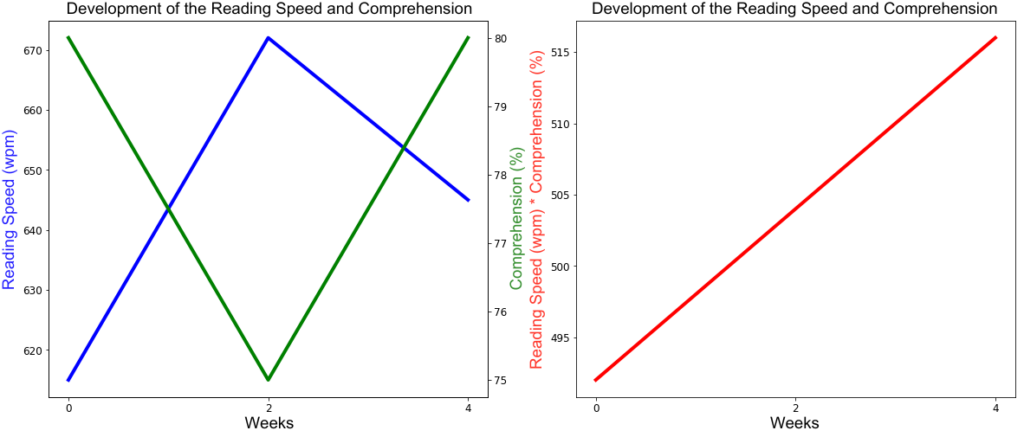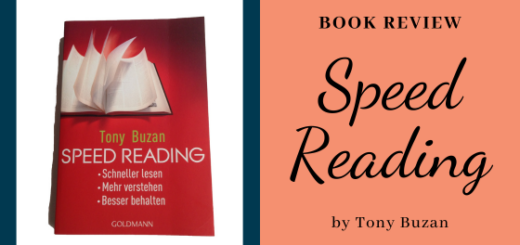9 Tips To Read Faster
Enhancing your reading speed gives you the ability to read more books and learn more quickly. Additionally, it can save you a lot of time in daily life by enabling you to read articles or emails faster. This section provides a guide to improving your reading speed.
The average reading speed ranges between 150 and 300 words per minute. With the tips outlined here and some practice, you should be able to double your reading speed without sacrificing comprehension. To test this, first determine your current reading speed by reading an easy-to-read text at a normal pace and timing yourself. Calculate your speed by dividing the number of words read by the reading time in minutes.

However, it’s not just about maximizing reading speed. It’s equally important to learn to adjust your speed to suit the material. You should balance speed and comprehension based on the type of text, as comprehension declines when speed increases past a certain point. Therefore, assess the speed at which you should read a text before beginning. The optimal reading speed will depend on your goals: for instance, if you really want to understand a text, read it more slowly than if you just want a general sense of it. Additionally, adjust your speed based on the material. Many non-fiction books can be read quickly to extract key information, while philosophical or fictional works should be read more slowly to fully immerse yourself and comprehend the material. Furthermore, when choosing your reading speed, consider the difficulty and value of the material. Don’t read a book more slowly than it deserves, nor so quickly that you can’t fully understand it.
Also, remember that successful reading involves more than just speed. For example, there’s no benefit to quickly reading books that don’t help you grow. As the graph on reading success shows, it’s not just about reading as many books as possible, but also about reading the right books, retaining what you read, and applying it to maximize your reading success.
Description of Speed-Reading Techniques
Use a Reading Aid
The first step to increasing reading speed is using a reading aid. For example, guide a pencil or chopstick under the line you’re currently reading. This helps you establish and maintain a reading rhythm, as the reading aid dictates the pace. It also improves focus and makes it easier to apply the following speed-reading techniques.
Practice by Reading Frequently
As you read more, you’ll naturally become a faster reader. With experience, you’ll also learn how to read and process texts and books more efficiently. You’ll become familiar with the structure of most books and where to find key information. As a result, you’ll be able to dynamically adjust your reading speed to the density of information in different sections, slowing down for important parts and skimming over less relevant ones. You can also skip sections that are unimportant to you.

Avoid Regression
When reading quickly, it’s essential to maintain your reading flow, so avoid going back to already-read sections, a habit known as regression. This often happens when you think you didn’t fully understand a section, but understanding will often emerge from the context if you keep reading. If needed, finish the paragraph before revisiting a part for clarification.
Fixate on Multiple Words at Once
Average readers typically fixate on each word individually, requiring around 500 fixations for a 500-word text. By learning to read multiple words per fixation, you can significantly improve your reading speed. For example, if you double the words read per fixation, you’ll double your reading speed. Advanced readers can read an entire line with a single fixation. To increase the number of words per fixation, train your peripheral vision, for example, using a Schulte table which is a 5×5 grid with 25 randomly arranged numbers. Practice by clicking the numbers from 1 to 25 while keeping your eyes focused on the table’s center.
Shorten the Duration of Each Fixation
Another way to increase reading speed is by minimizing fixation duration. For example, you can double your speed by halving the time you spend on each fixation. Practice by covering words or numbers with a sheet of paper and briefly lifting it to reveal the text. Try to remember what’s under the sheet in that brief moment.
Avoid Subvocalization
Subvocalization is the habit of silently pronouncing words as you read, which limits your speed to your speaking rate, about 150-200 words per minute. However, you’re capable of processing information faster. To test this, try listening to an audiobook or video at double speed. To stop subvocalizing, hold your tongue against your palate while reading. Subvocalization may be helpful with difficult sections to improve comprehension, so adjust your subvocalization and reading pace based on the text’s difficulty and importance.
Use Meta-Guides
Meta-guides enable you to make greater use of peripheral vision, allowing you to read faster. When practicing with meta-guides, read texts quickly without focusing on comprehension. Once accustomed to a high speed, resume normal reading with full comprehension.
The Two-Line Technique
With the two-line technique, read two lines at a time, guiding your reading aid under two lines before moving it to the next pair of lines. This technique engages both horizontal and vertical vision, enhancing reading speed further.
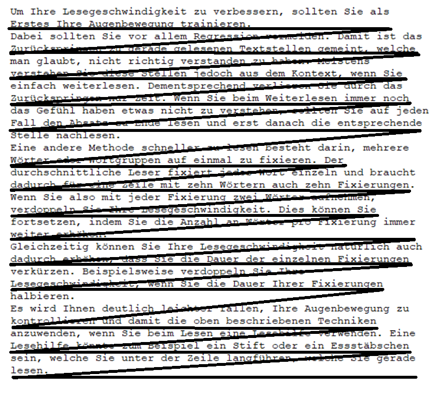
The Backward Swing
The backward swing doubles your reading speed by not simply moving your eyes to the beginning of the next line at the end of a line but by reading the next line backward and then starting with the line after that. This backward reading technique works when you take in multiple words per fixation, allowing you to recognize the correct order of the words.
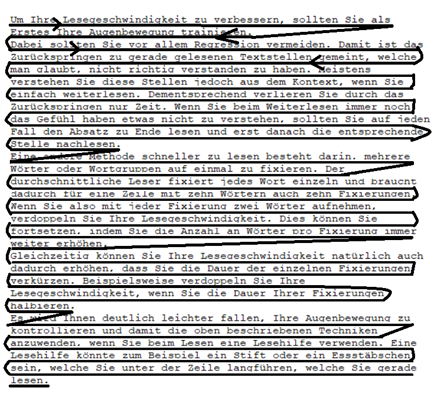
The “S” Method
With the “S” method, you guide your reading aid in the shape of an “S” down the page, capturing the text both forward and backward. This technique enables you to achieve very high reading speeds.
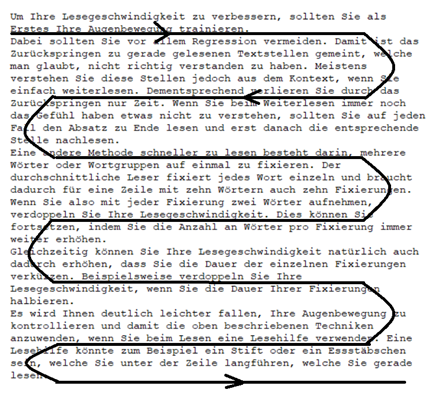
Taking Regular Breaks
While reading, you should take a 5-minute break every 30 minutes to keep your concentration high. During the short break, get up and move around a bit. Additionally, it is advisable to take a longer break every two hours. This way, you can optimally focus on the reading material over long periods.
Preparing for the Reading Material
Before reading, you should first get an overview. Try to determine what the topic of the text is, how it is structured, and what the author’s intention is. To do this, skim through the text and look at the (sub)headings, individual sections, and illustrations. Also, briefly read the introduction and the conclusion at the end of the text.
Before reading a book, you should also skim the following parts of the book:
- The title and back cover
- Table of contents
- Index
- Author’s bio
- Key chapters (e.g., summaries/conclusions at the end of chapters)
- Briefly flip through and read a few sections (such as the preface and conclusion)
Before reading a book, you should skim through its essential parts. After you have gained an overview, formulate some questions that you hope to answer by reading the text. Pay special attention to finding answers or clues to your questions while reading. This way, you will know exactly what you are looking for and where to find it in the text. Consequently, you can significantly increase your reading speed and adjust it according to the information content of the individual sections. For example, you can read the sections that are irrelevant to your questions very quickly or skip them altogether. On the other hand, you can read the critical sections more slowly and attentively.
Application of Speed-Reading Techniques to Read Faster
For practicing speed-reading techniques, the metronome training method is particularly suitable. In this method, you read an easily readable text with a reading aid faster than usual. For example, try to read a text in the following manner while understanding as much as possible:
- Read for one minute at 100 words per minute (WPM) faster than normal
- Increase your speed by another 100 WPM
- Increase it three more times by 100 WPM each
- Read at this speed for one minute while focusing on comprehension
You should practice this exercise daily to increase your reading speed. You can also vary the exercise a bit. For example, you can reverse the exercise by starting as quickly as possible and then gradually slowing down. This way, you can notice how your comprehension improves steadily, even at still high reading speeds.
You can use any text for training, but initially, it is advisable to choose texts or books you have read before. This makes it easier to understand something even at high reading speeds. Later, you can include more new texts. It is particularly useful to use texts you want to read anyway as a preliminary exercise for speed-reading techniques. This way, you will realize during the second read-through at a normal reading speed how much you understood the first time using speed-reading techniques.
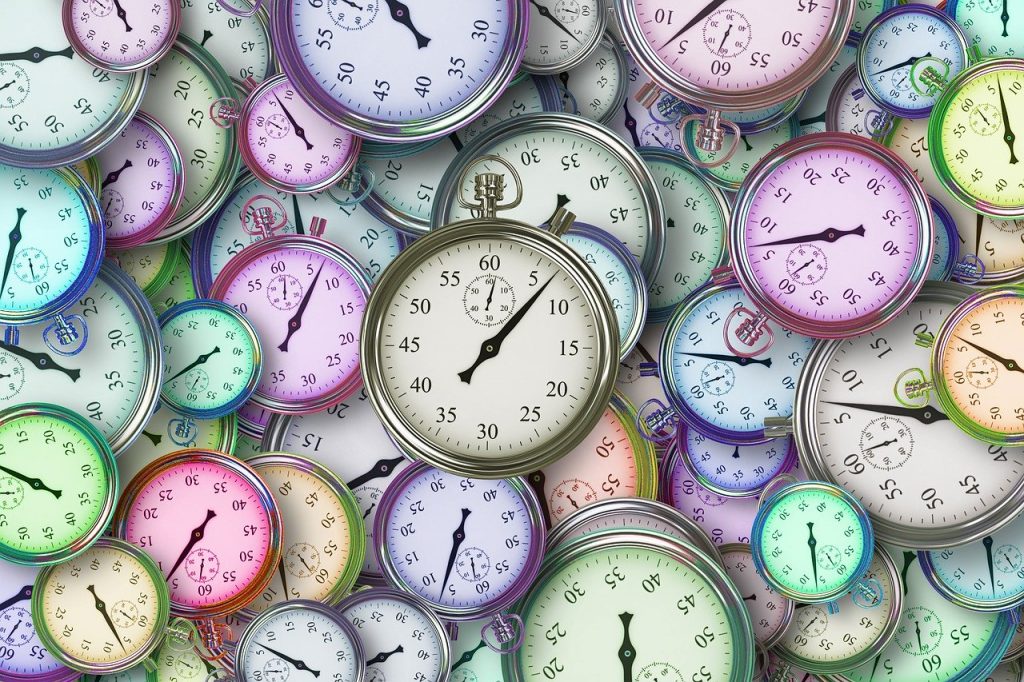
Additionally, you should regularly test your reading speed to monitor your progress. To do this, read a new text as quickly as possible and then answer questions about it to test your comprehension. You should conduct this test every two weeks. Each time, record your reading speed in words per minute as well as your comprehension percentage, which can be calculated as follows:
Reading Speed = Number of words read / Reading time in minutes
Comprehension = (Number of correctly answered questions / Total number of questions) * 100
You can then easily enter these values into the following table:

Additionally, you should set a personal goal for the reading speed you want to achieve at a certain level of comprehension. To further boost your motivation, you can visually represent your progress. Create a graph using your table with your reading speed and comprehension on the y-axis and time on the x-axis. You can draw one line for your reading speed and another line for your comprehension, or you can combine the two values into one by multiplying them. For example, for the entries from the above table, you would get the following values:
615 * 80% = 492
672 * 75% = 504
645 * 80% = 516
